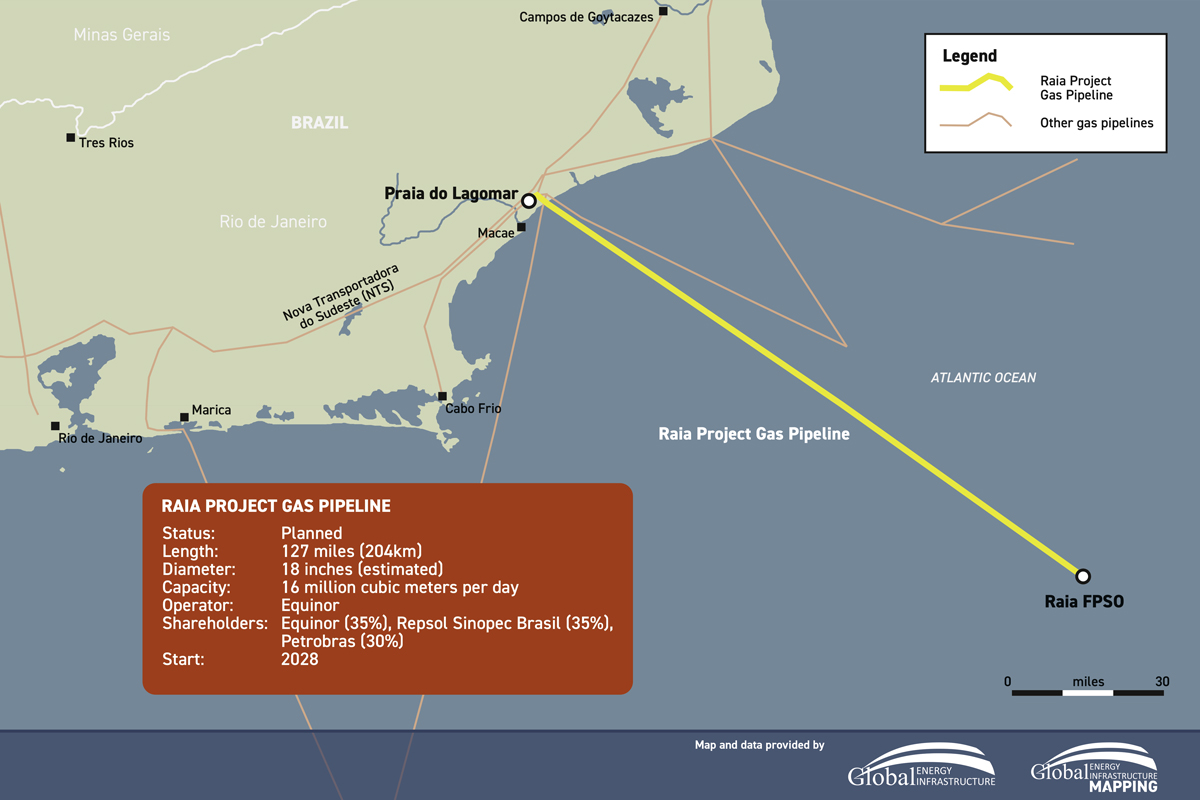Equinor’s 127-Mile Offshore Pipeline in Brazil Gets Early Construction Approval
(P&GJ) — Brazil’s Energy Research Company (EPE) has greenlit a key technical step for a proposed offshore pipeline project led by Equinor, aimed at transporting natural gas from the Raia fields in the pre-salt region of the Campos Basin to the national grid, according to Brazil Energy Insight.
The EPE’s approval clears the way for early-stage construction and installation work to begin.
According to EPE, the project aligns with Brazil’s strategic energy goals, particularly its Gas for Employment Program, which seeks to tap domestic gas resources to lower energy costs and strengthen infrastructure. EPE President Thiago Prado emphasized that the evaluation process upheld technical rigor and met all deadlines, adding that this move demonstrates how energy planning can drive investment and infrastructure security.

Pipeline Route and Information
For an overview of this project and other related infrastructure developments, visit Global Energy Infrastructure.
The gas pipeline will span a total of 204 kilometers (127 miles), primarily offshore, linking production units near the Raia Manta and Raia Pintada fields—located roughly 200 kilometers (124 miles) off the coast of Rio de Janeiro—to Macaé in the state of Rio de Janeiro. A unique feature of this project is that all gas processing will occur at sea, allowing the pipeline to deliver ready-to-transport gas directly into the national system without the need for onshore processing facilities—a first for Brazil.
The pipeline system includes an offshore connection to a floating production, storage and offloading unit (FPSO), which will feed gas to the seabed pipeline. The offshore portion will reach depths of about 2,700 meters and will be protected by burial in shallow areas. It will make landfall at Praia do Lagomar using horizontal directional drilling (HDD) and continue onshore for 4 km via a corridor already used by other pipelines.
Onshore, the pipeline will link to the Gas Receiving Station (ERG), where it will connect to Nova Transportadora do Sudeste’s (NTS) pipeline network. The pipeline route will cross two highways and run near protected areas and residential neighborhoods. It will also feature a PIG system (Pipeline Inspection Gauge) for internal maintenance and monitoring.
The Raia project is operated by Equinor (35%) with partners Repsol Sinopec (35%) and Petrobras (30%). It comprises three significant pre-salt finds—Pão de Açúcar, Gávea, and Seat—with combined recoverable resources estimated above 1 billion barrels of oil equivalent (boe). Once operational in 2028, the pipeline could deliver up to 16 million cubic meters of natural gas daily—enough to cover around 15% of Brazil’s domestic demand.
Nearly all the pipeline steel is being sourced and manufactured domestically, supporting Brazil’s local supply chain.
Raia is also designed with low-emission energy production in mind. The FPSO will use combined-cycle gas turbines to significantly lower carbon output, aiming for an average emissions intensity of under 6 kilograms of CO₂ per barrel—among the lowest in the industry. The field is expected to generate up to 50,000 jobs throughout its lifecycle and represents a $9 billion investment in Brazil’s energy security and gas market expansion.
The Author
Related News
Related News

- Enbridge Plans 86-Mile Pipeline Expansion, Bringing 850 Workers to Northern B.C.
- Intensity, Rainbow Energy to Build 344-Mile Gas Pipeline Across North Dakota
- U.S. Moves to Block Enterprise Products’ Exports to China Over Security Risk
- Strike Pioneers First-of-Its-Kind Pipe-in-Pipe Installation on Gulf Coast with Enbridge
- 208-Mile Mississippi-to-Alabama Gas Pipeline Moves Into FERC Review
- U.S. Pipeline Expansion to Add 99 Bcf/d, Mostly for LNG Export, Report Finds
- A Systematic Approach To Ensuring Pipeline Integrity
- 275-Mile Texas-to-Oklahoma Gas Pipeline Enters Open Season
- LNG Canada Start-Up Fails to Lift Gas Prices Amid Supply Glut
- Strike Pioneers First-of-Its-Kind Pipe-in-Pipe Installation on Gulf Coast with Enbridge





Comments